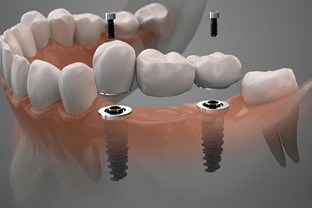Dental Bridge – Peabody
Fill in the Gap in Your Smile
 Missing just one tooth can make a huge difference in your quality of life. Chewing, speaking clearly, and smiling
without feeling self-conscious are just some of the ways that tooth loss can take a toll. Fortunately, if you are
missing one or a few consecutive teeth, a dental bridge in Peabody could be the exact thing you need to give you
your smile back. Continue reading to learn more about dental bridges and how they work. For more information or to
schedule a consultation, don’t hesitate to give us a
call!
Missing just one tooth can make a huge difference in your quality of life. Chewing, speaking clearly, and smiling
without feeling self-conscious are just some of the ways that tooth loss can take a toll. Fortunately, if you are
missing one or a few consecutive teeth, a dental bridge in Peabody could be the exact thing you need to give you
your smile back. Continue reading to learn more about dental bridges and how they work. For more information or to
schedule a consultation, don’t hesitate to give us a
call!
Why Choose Dr. Spiro Saati DMD for Dental Bridges?
- State-of-the-Art Dental Technology
- Dental Financing Options
- Saturday Visits Available
What Is a Dental Bridge?

Dental bridges fill in the gap left behind by missing teeth. A bridge may contain one or more false teeth, also called pontics. Together with two dental crowns, a bridge provides a permanent tooth replacement. The crowns are anchored onto the healthy adjacent teeth or dental implants, depending on the type of bridge you get. The restoration can be made from a variety of durable, natural-looking materials that blend in seamlessly with the rest of your smile.
Types of Dental Bridges

There are two different types of dental bridges that help to meet different needs. Here is what each one is comprised of.
Traditional Dental Bridge
For patients who have healthy teeth on either side of the gap, a traditional denture is usually ideal. The teeth that support the dental crowns are known as “abutment teeth,” and they are altered slightly so the bridge fits comfortably in the mouth. This type of restoration can be placed in just a few visits to the dental office and is typically more affordable than their implant counterparts.
Implant Bridge
If you don’t have healthy adjacent teeth, surgically implanted metal posts, also known as dental implants, can work as an alternative. Dental implants can be used when there are three or more missing teeth in a row. Implant bridges tend to last longer than traditional bridges on average, and they prevent bone loss from occurring over time.

The Benefits of Getting a Dental Bridge
Here are some of the benefits you can experience when you opt for a dental bridge:
Dental Bridges FAQs
Can You Take a Dental Bridge Out?
Perhaps because other restorations (like dentures) are removable, many patients want to know whether their dental bridge can also be taken out. The answer is that no, this type of prosthetic isn’t intended to be removed except by a professional. Instead, it is cemented on either side to either healthy teeth or implants that have fused with your jawbone, making it an excellent long-term solution to bridge the gap in your grin.
Is Getting a Dental Bridge Painful?
It’s easy to assume that any restorative treatment is bound to be long and agonizing, but that’s thankfully not the case. Before beginning your procedure, our team will administer a local anesthetic to numb the area so you feel comfortable the entire time. If you have a hard time sitting still or are still overly anxious, we might also administer a sedative.
Placing your dental bridge involves removing some enamel from the abutment (supporting) teeth so that the prosthetics fit over them without looking overly bulky. It’s normal to feel some sensitivity for a few days after this, but usually, symptoms are mild and can be addressed with over-the-counter medications like Tylenol or ibuprofen.
If you have pain that doesn’t subside or gets worse, please contact us right away so we can schedule an appointment to ensure you haven’t developed a complication.
How Long Should a Dental Bridge Last?
Typically, these prosthetics last anywhere from 5 to 15+ years. The longevity of yours depends on different factors, such as:
- Its location. Restorations in the back of your mouth sustain more pressure from chewing, which can break them down sooner.
- The materials it’s made from. Porcelain is more lifelike and doesn’t cause sensitivity like metal amalgam, but it also doesn’t last as long.
- Your dental hygiene habits. Although your bridge itself cannot develop disease or decay, your remaining teeth and gums can. You need to brush and floss twice daily to remove plaque buildup and protect and preserve your grin.
What Can You Not Eat with a Dental Bridge?
One of the greatest benefits of refurbishing your smile with a dental bridge is that it restores a great deal of your chewing power. These artificial teeth are strong and durable, so you can enjoy a wide array of healthy ingredients to give your body all the nutrients it needs.
However resilient your dental bridge may be, though, it’s not entirely invincible. Certain foods can harm the materials and should be avoided. For example, sticky ingredients could loosen or dislodge it altogether, while overly hard or crunchy options can chip, crack, or abrade its surface.